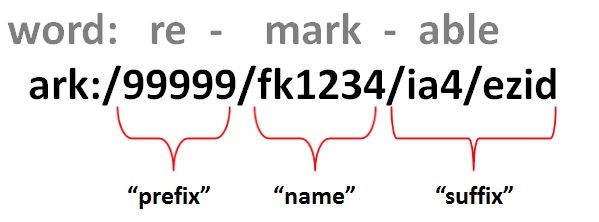Identifier Wild Card! Introducing Suffix Pass-through
Earlier this year, the ARK resolver software was upgraded in some important ways, most of which were technical enhancements that improve performance and/or lay the groundwork for interesting things to come. One change we can now make available is an exciting feature we have been looking forward to introducing for some time: suffix pass-through.

Think of this as an identifier wild card. With suffix pass-through, if you have an identifier (call it N) pointing to a target URL (call it T), then any new links (“requests”) for N plus any suffix (call it S), or “N/S” will take you to “T/S” even though you did not register a target URL of T/S.
To follow this bit of logic, you may need a little brush up on identifier anatomy. ARK identifiers can have three parts, usually separated by slashes.
You can compare this to the parts of a word: a prefix (similar to a DOI prefix), a name, and an optional suffix. The prefix identifies the organization or entity registering identifiers, the name identifies the object being registered, and the suffix, if any, is supplied by an end user.
 Why is suffix pass-through so important? Imagine you have a dataset with 10,000 nameable components. You’d like to be able to reference these components for tracking purposes, but the burden of registering and managing 10,000 identifiers seems prohibitive. Consider the alternative: with suffix pass-through, you advertise ARKs with suffixes, just as if you’d registered them all, but you only take on management of one identifier. (Of course the data files at the target server still have to be managed.) Pretty wild, isn’t it?
Why is suffix pass-through so important? Imagine you have a dataset with 10,000 nameable components. You’d like to be able to reference these components for tracking purposes, but the burden of registering and managing 10,000 identifiers seems prohibitive. Consider the alternative: with suffix pass-through, you advertise ARKs with suffixes, just as if you’d registered them all, but you only take on management of one identifier. (Of course the data files at the target server still have to be managed.) Pretty wild, isn’t it?
For more information and working samples, see https://confluence.ucop.edu/display/DataCite/Suffix+Passthrough+Explained
